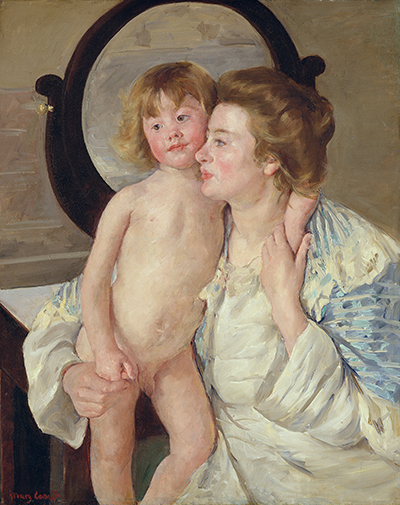The Impressionists as a group tended to steer clear of religious iconography, but as a conventionally raised American girl, Mary Cassatt would no doubt have received a strong indoctrination in biblical tales.
The story of Mary and the infant Jesus would have appealed to her strong feminist instincts – as miraculous as Jesus was, surely to be the mother of the messiah would be something to take pride in, as well as be something which would have required tremendous strength? Whether Cassatt felt this way or not, she definitely did paint many pictures along the theme of this one. 'Woman and Child' (sometimes called Mother and Child) shows a woman and a young child – often they are only just growing out of babyhood – engaged in those sweet domestic intimacies that childhood or maternity demand.
There is no discernible activity in the image, it seems – as do so many of Cassatt's works – to have caught a snapshot of a quiet, contemplative moment. The child, a boy, is leaning against his mother, standing on a bed or similar platform, his arm slung casually around her neck, while the weight of his body leans on her, drawing comfort or strength – or both – from her. He is naked and vulnerable, and yet is completely unselfconscious, a statement of the pure innocence of childhood, before the weight of education and manners are overlaid his form?
The mother, too, is staring off into the distance. She is aware of the weight and shape of her son and she is holding both his hands: one reaching up to hold the hand of the arm around her shoulders, while the other is curved around his body protectively, grasping his other hand – but her grip is welcome, his small hand is clutched onto hers. So both are lost in their own thoughts, and yet simultaneously fully aware of the whereabout and welfare of the other. The mother is sweetly plump: a soft double-chin blurs the sharp line of her jaw, and her neck is rounded. She seems tired, as evidenced by the touch of a flush along her cheekbones, and the looseness of her bun, her hair seemingly about to tumble from its confines about her shoulders.
An oval mirror behind their heads gives the impression of a halo, something which Edgar Degas – Cassatt's dear friend and mentor and, by this time, colleague in the Impressionist movement, along with Berthe Morisot, that other female star of the Impressionist movement – picked up on and gently derided her for. He said the painting depicted 'the Infant Jesus and his English nursemaid', an epithet to which history does not give s Cassatt's response! However, others did like the barely hidden religious imagery and the painting was snapped up, and can now be found in the Metropolitan Museum of Art's Fifth Avenue gallery. It is in oils on canvas.




